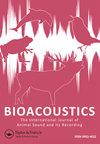避免捕食的单色牛蛙(直翅目:肺炎科)叫声活动的时间划分
IF 2.1
4区 生物学
Q2 ZOOLOGY
Bioacoustics-The International Journal of Animal Sound and Its Recording
Pub Date : 2023-01-30
DOI:10.1080/09524622.2023.2170469
引用次数: 0
摘要
摘要生态相互作用,包括竞争、捕食和环境条件,可能会显著影响声学信号行为。在这里,我们描述了膀胱蝗虫Bullacris unicolor的夜间信号模式,并将其与生物和非生物因素联系起来,从而深入了解声学信号行为的生态驱动因素。被动声学记录器监测了单色蝙蝠分布的焦点物种、竞争对手和捕食性蝙蝠的夜间叫声活动。结果表明,B.unicolor优先在夜间的某些时间发出叫声,但活动高峰期因地理范围而异。单色B.unicolor的活动与蝙蝠的活动有很强的相关性。再往北的Bullacris单色种群总体上避开了蝙蝠的回声定位呼叫周期,而再往南的地方,观察到了B.unicolor和蝙蝠回声定位之间的呼叫周期重叠。北部地区的蝙蝠在夜间早些时候表现出明显的活动期,因此,单色蝙蝠可以通过将信号活动转移到夜间晚些时候来降低捕食风险。相比之下,蝙蝠在南部地区整晚都很活跃,B.unicolor在其分布的这一区域没有延迟呼叫活动,尽管该物种确实稍微改变了信号,以减少与共存的无肺物种的峰值重叠。本文章由计算机程序翻译,如有差异,请以英文原文为准。
Temporal partitioning of Bullacris unicolor (Orthoptera: Pneumoridae) calling activity to avoid predation
ABSTRACT Ecological interactions, including competition, predation, and environmental conditions, may significantly impact acoustic signalling behaviour. Here we characterise nocturnal signalling patterns in the bladder grasshopper Bullacris unicolor and relate this to biotic and abiotic factors, thus providing insights into ecological drivers of acoustic signalling behaviour. Passive acoustic recorders monitored nocturnal calling activity of the focal species, competitors, and predatory bats across the distribution of B. unicolor. Results indicate that B. unicolor calls preferentially at certain times of the night, but that peak activity period varies across the geographic range. There was a strong relationship between B. unicolor activity and bat activity. Bullacris unicolor populations further north showed an overall avoidance of bat echolocation call period, whereas further south an overlapping of call periods between B. unicolor and bat echolocation was observed. Bats at northern sites showed a distinct activity period early in the night and B. unicolor may thus reduce predation risk by shifting signalling activity to later in the night. In contrast, bats were active throughout the night at southern sites and B. unicolor did not delay calling activity in this region of its distribution, although the species did shift signalling slightly to reduce peak overlap with co-existing pneumorid species.
求助全文
通过发布文献求助,成功后即可免费获取论文全文。
去求助
来源期刊
CiteScore
4.50
自引率
0.00%
发文量
25
审稿时长
>12 weeks
期刊介绍:
Bioacoustics primarily publishes high-quality original research papers and reviews on sound communication in birds, mammals, amphibians, reptiles, fish, insects and other invertebrates, including the following topics :
-Communication and related behaviour-
Sound production-
Hearing-
Ontogeny and learning-
Bioacoustics in taxonomy and systematics-
Impacts of noise-
Bioacoustics in environmental monitoring-
Identification techniques and applications-
Recording and analysis-
Equipment and techniques-
Ultrasound and infrasound-
Underwater sound-
Bioacoustical sound structures, patterns, variation and repertoires

 求助内容:
求助内容: 应助结果提醒方式:
应助结果提醒方式:


